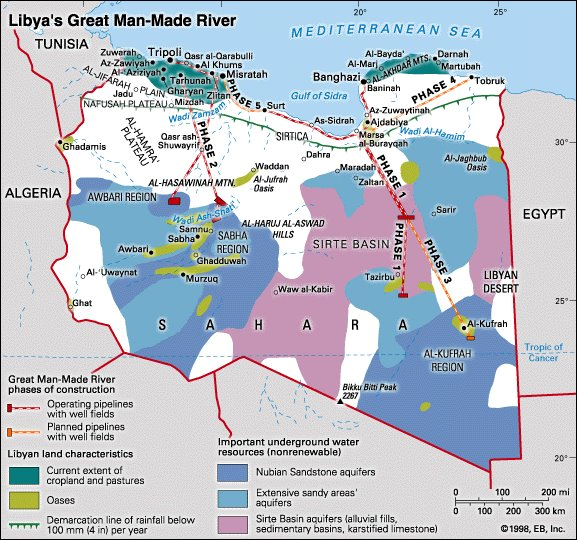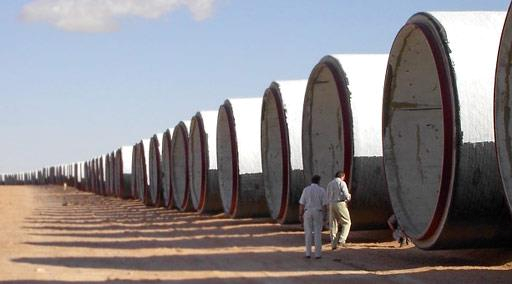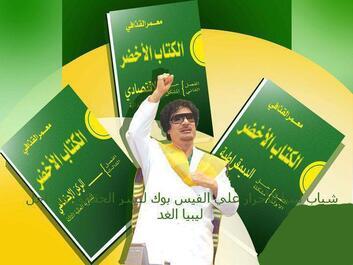
Advertisement
Great Man Made River Project

Expansion of Pipelines
Over 1,000 km of new pipeline segments were laid to connect smaller towns and expand water delivery to underserved regions.
New Pumping Stations
Multiple large-scale pumping stations were constructed and tested, including those intended to support Phase I and Phase II systems, with upgrades to allow for deeper water extraction and longer transport routes.
Reservoir Expansion
Construction of additional concrete-lined holding reservoirs near Sabha, Sirte, and western agricultural zones was underway, with some operational by 2010.
Automation & Monitoring
Introduction of SCADA systems (Supervisory Control and Data Acquisition) for centralized monitoring of water flow and pressure levels.
Agricultural Integration Projects
Pilot farms and irrigation zones, especially in Fezzan and parts of the Sahel belt, had been connected to the GMMR by late 2010.
In 2011, during the NATO-led military intervention in Libya, critical parts of the GMMR system were bombed, including civilian infrastructure—prompting international concern.
Brega Pipe Factory Bombed (July 22, 2011)
NATO airstrikes destroyed the pipe manufacturing plant in Brega, the only facility in Libya producing the large concrete pipes used in the GMMR project.
This was a strategic and irreversible loss, halting further expansion and maintenance capacity.
Pumping Stations Targeted
Satellite and media reports indicate that at least one major pumping station (associated with Phase II/IV systems) near Al Jufrah was damaged or disabled.
Collateral Damage to Pipe Routes
Reports from engineers and UN-affiliated organizations later documented damage to segments of pipeline near Sabha and Sirte due to both aerial bombardment and ground fighting.
Civilian Workers Killed
Reports confirmed casualties among GMMR maintenance and engineering staff, including during the Brega factory strike.
Note: NATO claimed the bombings were aimed at military targets, alleging the use of the factory for military purposes—claims not substantiated by independent observers.
Despite extensive damage during the war and political instability since:
Much of the core GMMR infrastructure is still functional, especially older Phase I and II routes supplying major cities like Tripoli, Benghazi, and Misrata.
Water delivery has been intermittent in some regions due to maintenance difficulties, sabotage, power outages, and lack of spare parts.
Libyan engineers, working with limited support, have continued to keep parts of the GMMR operational despite the lack of international aid.
Repair work has been occasionally funded by local councils, private sector players, or interim governments, but a nationwide restoration remains stalled due to continued instability and fragmentation of governance.
Phases IV and V of the GMMR were Libya's most advanced attempt to modernize and complete the dream of water independence. The destruction of critical infrastructure during the NATO intervention in 2011—particularly the Brega Pipe Factory—crippled Libya’s ability to finish or maintain this monumental project.
As of 2025, the GMMR still supplies millions with water, a testament to the original engineering and ambition behind it, but it operates at reduced capacity, with significant long-term vulnerabilities.

Great Man Made River Project 1984 - 2011
Project Name: Great Man-Made River (GMMR)
Initiated by: Muammar Al Gaddafi
Start Date: Officially launched in 1984
Scope: Transfer of water from As-Sarir and Tazerbo wells to Benghazi and Sirte
Infrastructure: 1,600 km of pipeline
Storage: Construction of large reservoirs like Omar Mukhtar Reservoir
Scope: Supply of water from Fezzan (southern Libya) to the Western coastal belt including Tripoli
Pipelines: Roughly 1,300 km
Built to serve: Capital Tripoli and surrounding areas
Goal: Link the eastern and western systems and expand connections to more towns
Integration: Unified water grid across major urban and agricultural zones
Enhancements: Construction of additional pipelines, pumping stations, and reservoirs
Status: Partially completed due to NATO bombing in 2011, which damaged GMMR facilities and halted work
In the ninth month of the year (1984) began work on a Great Man Made River to transport groundwater basins infidels and bed and Tazrbu and Fezzan in the south to the cities of Benghazi and Sirte and Tripoli, Tobruk and other coastal cities in the north through the system, huge pipes huge total extension of about (3.380 ) kilometers was set up two plants in the bed and Brega for the provision of these tubes made of material concrete the previous stress and is buried in the trenches of the underground at a depth of (7) meters have been drilled (960) wells at depths ranging from (450) meters, and between (650) meters in the basin Tazrbu bed and Fezzan and Kufra.

The Great Man-Made River (GMMR) – Libya’s Forgotten Engineering Wonder
Often referred to as “the eighth wonder of the world,” the Great Man-Made River (GMMR) was one of Muammar Al Gaddafi’s most ambitious and visionary projects — a massive underground water system designed to bring fresh water from the Saharan desert aquifers to Libyan cities and farmlands.
This vast, self-funded infrastructure project transformed arid land into productive farmland and provided clean drinking water to millions, without foreign debt or Western control.
Though heavily damaged and forgotten after the 2011 NATO-backed war, its legacy stands as a powerful symbol of African self-reliance and visionary engineering.
You can explore more about this incredible project via the archived official website below:
🔗 Archived GMMR Website (via Web Archive)
📌 Note: For best viewing, please use a desktop or laptop device, as the archived website layout may not be mobile-friendly.
Working on more content!
Re-building this great project website
Advertisement

Read the GREEN BOOK